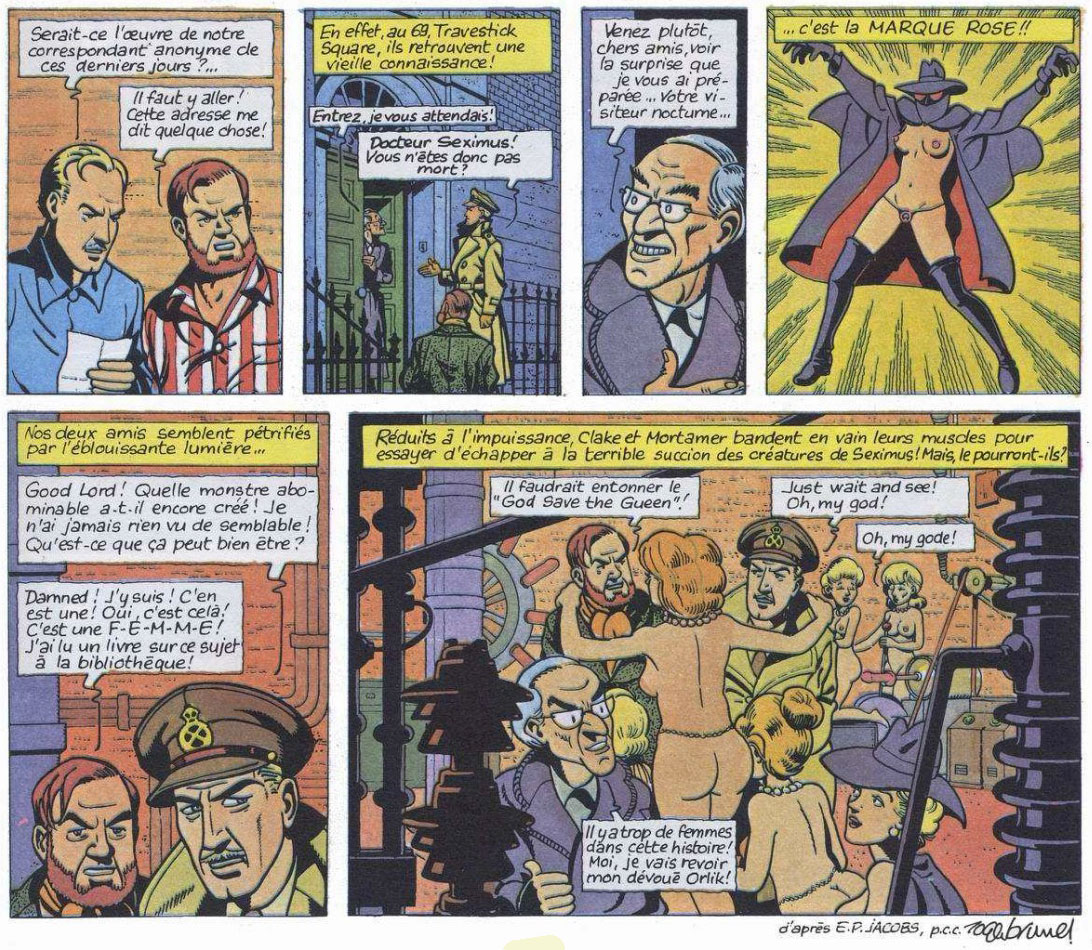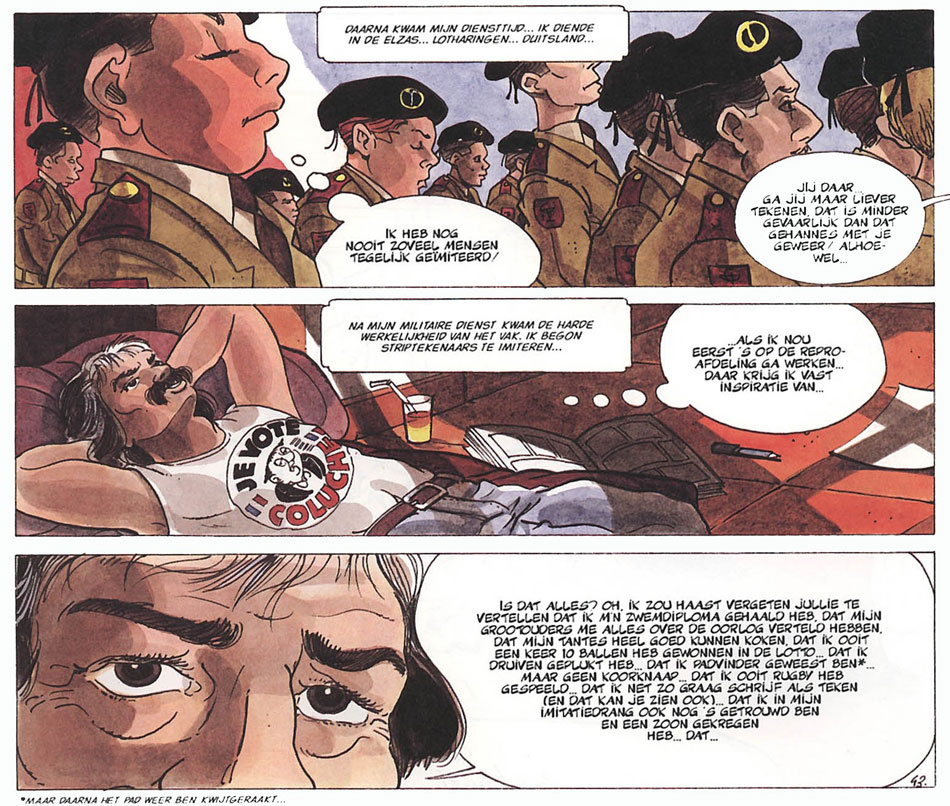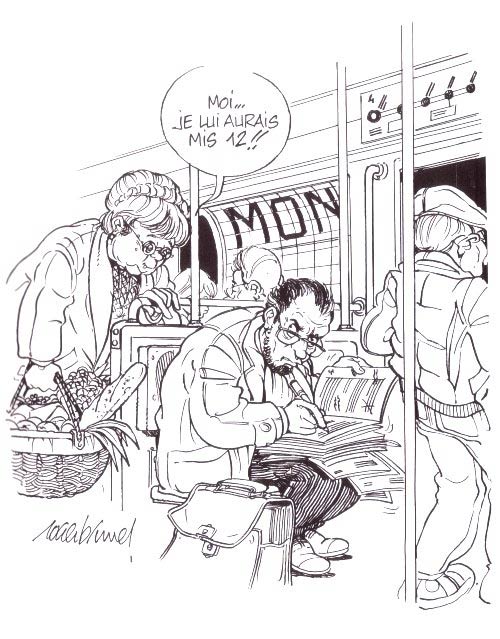All-star sex parody by Roger Brunel in 'Pastiches 5' (1989). Dutch-language version. We recognize cameos from Brunel's own character, Parodine, Jacques Martin's Alix, Albert Uderzo's Astérix & Obélix and a Roman, Hergé's Tintin, Snowy, Captain Haddock and Professor Calculus, André Franquin's Spirou, the Marsupilami, Gaston Lagaffe, Jean Tabary's Iznogoud, Morris' Lucky Luke and E.P. Jacobs' Blake and Mortimer.
Roger Brunel is a French comic artist and cartoonist, based in the Dombes area. He is best-known for his pornographic parodies of classic comic heroes, released under the title 'Pastiches' (1978-1995). Translated in several languages, Brunel's sex parodies distinguish themselves from other porn parody comic artists through their fine artwork and witty comedy. By mocking many different series, artists and genres, his spoofs offer tremendous variety. Receiving admiration from comic critics and even some of the spoofed artists, Brunel became a rare example of a porn parody comic artist actually winning an award for his work. As a scriptwriter, he is notable for the adventure series 'Le Solitaire' (1987-1990), drawn by Alain Mounier, and various topical humor comics, often with art by Michel Rodrigue. As head of Glénat Concept, he specialized in promotional and educational comics. One series in this latter genre, drawn by Brunel himself, was 'Tel et Matic' (1981-1982), published in the magazine Gomme.
Early life and career
Roger Brunel was born in 1944 in Valence and studied at the School of Fine Arts in Grenoble. He had his first job at a printing firm, and then became a designer in the advertising field. Throughout the 1960s, he made caricatures and humorous drawings for the newspapers Le Progrès de Lyon, La Presse and Le Hérisson. Brunel's first short comic story, 'Graphos et Mandou', appeared in Spirou magazine in 1972. He then began an association with the Grenoble-based publishing house Glénat, where he started out as a graphic designer.
Cover illustration of 'Pastiches 2', an America-themed parody comic book by Brunel. From left to right one can recognize Spider-Man (Steve Ditko, Stan Lee), Red Ryder (Fred Harman), Prince Vailiant (Harold Foster), Brick Bradford (William Ritt, Clarence Gray), Superman (Jerry Siegel and Joe Shuster), Terry (Milton Caniff), Blue Bolt (Joe Simon), Rip Kirby (Alex Raymond), Mandrake the Magician and The Phantom (Lee Falk), Dick Tracy (Chester Gould), The Spirit (Will Eisner), Dagwood Bumstead (Chic Young), Alley Oop (V.T. Hamlin), Popeye (E.C. Segar), Krazy Kat (George Herriman), Pink Panther (Friz Freleng), Pogo (Walt Kelly), Peter (Johnny Hart), Li'l' Abner (Al Capp), Buck Rogers (Dick Calkins), Little Orphan Annie (Harold Gray), Buster Brown (Richard F. Outcault), Little Nemo (Winsor McCay), Bugs Bunny (Tex Avery), Jiggs (George McManus), Tom & Jerry (Hanna-Barbera), Felix the Cat (Otto Messmer, Pat Sullivan), Perry Winkle (Martin Branner), Der Katzenjammer Kids (Rudolph Dirks), Tarzan (Harold Foster), Donald Duck and Mickey Mouse (Walt Disney).
Sex parodies
In 1978, Brunel started making porn parodies of famous comics, which appeared in Circus magazine and were published in book format by Glénat under the title 'Pastiches'. In a sense, he continued in a long tradition. As early as the 1930s, porn parody comics had been in circulation, for instance the digest-sized "Tijuana Bibles" in the USA, which were sold illegally under the counter. By the early 1970s, most Western countries had legalized pornography, allowing a whole new market for erotic comics. Soon after, sex parody comics became very popular, almost to the point of being a craze. The brand recognition of the spoofed comics guaranteed decent sales. In general, sex parody comics were a counter reaction to the strict censorship of previous decades, when comic artists were straightjacketed to only draw family-friendly stories about generally upright, infallible and asexual heroes. While the parodists no longer had to fear violating obscenity laws, they could still be prosecuted for copyright infringement. Many of these porn spoofs were therefore still left unsigned.
Parody of Jean Roba's 'Boule et Bill'. Dutch-language version.
Roger Brunel is a rare example of a porn parody comic artist who managed to build a career out of this niche, and even signed his stories with his real name. His spoofs sold well and were actually praised by critics and professional cartoonists. In issue #240 (24 December 1990) of the Dutch comic news magazine Stripschrift, Belgian comics journalist Patrick Van Gompel wrote that Brunel's sex parody comics were arguably the best ones around. Brunel achieved this reputation by distinguishing himself from his colleagues. Most other porn parody comic creators were amateurs who could barely draw and therefore traced or photocopied entire panels from other comic books. Familiar characters received some exposed breasts or genitals on their bodies, while being maneuvered in sex positions. The crude artwork typically looks awkward and pathetic instead of titillating, or funny, for that matter. Several of these "dirty books" are brimful with long-winded, improvised filler, just to get to the sex scenes and the amount of pages needed for a book release. Beyond the cheap gimmick of showing iconic comic characters having sex, the artists had nothing else to offer.
Roger Brunel spoof of the serious 'Blake & Mortimer' comics by E.P. Jacobs (from: Pastiches 1). Blake and Mortimer are amazed to see a woman in their all-male universe. Mortimer knows what "that creature" is: "It's a W-O-M-A-N. I've read a book about it in the library."
Brunel, on the other hand, made actual pastiches. He took great effort in mimicking the graphic style and overall spirit of the original comics. He spent as much attention to the characters as the lay-outs and the backgrounds. The familiar tropes and clichés of each series are directly mocked. In his spoof of Edgar P. Jacobs' 'Blake & Mortimer', for instance, the deeply serious tone, unnecessary explanatory text captions and lack of prominent female characters are a source of comedy. Brunel's parody of Winsor McCay's 'Little Nemo' has the boy wake up in the final panel as usual, but this time from a wet dream. In 'Pastiches 5', military pilot Buck Danny has sex with his female nemesis Lady X. Their body parts are given technical descriptions, mocking the explanatory models of airplanes in the 'Buck Danny' albums by Victor Hubinon and Jean-Michel Charlier. Buck's penis is described as a "model with moveable tip", X's breasts as "reservoir tanks" and her mouth as a "sucking mechanism."
A typical Brunel parody is one, two or sometimes three pages long, allowing him to put the funniest ideas together in a well-structured narrative that doesn't overstay its welcome. Although his 'Pastiches' are often classified as "pornography", the nudity and sex scenes in Brunel's comics aren't very explicit. Much of the actual action takes place off-screen. Brunel described his porn parodies as "sex comedy" rather than straight-out masturbation material: "A lot of what I implied was in the dialogue and the rest left to the readers' imagination."
Parody of Al Capp's 'Li'l Abner'. Dutch-language version.
As a parodist, Brunel showed great ambition. He tackled many different comic series, artists, styles and genres, giving enough variety for compilations in thematic books. The first volume of 'Pastiches' (Glénat, 1980) pokes fun at several major French and Belgian series. In 'Pastiches 2' (Glénat, 1982), Brunel went overseas by mocking classic U.S. newspaper strips and comic book characters, challenging him to try his hand at a great variety of drawing styles. In the third volume of 'Pastiches' (Glénat, 1984), Brunel brought together extra Franco-Belgian comics he hadn't covered yet.
Most of Brunel's previous 'Pastiches' focused on family-friendly comics, subverting their innocence with dirty jokes. With 'Pastiches. École Adulte' (Glénat, 1986), Brunel went for European comics aimed at mature readers, including work by Jacques Tardi, F'murr, Hugo Pratt and Enki Bilal. He lampooned their complicated plots, sophisticated commentary and, at times, pretentiousness. For Vents d'Ouest, Brunel additionally made 'Le Manga Pastiche' (1995), ridiculing manga series like Osamu Tezuka's 'Astro Boy', Akira Toriyama's 'Dragon Ball', Go Nagai's 'Goldorak' and Naoko Takeuchi's 'Sailor Moon'. While most of Brunel's comics are short stories, his 'Pastiches 5' (1989) and 'Pastiches 6' (1993) were full-length albums uniting dozens of characters from various Franco-Belgian series in one narrative.
Realism in 'Pastiches 6' (1993).
Pastiches: success
Roger Brunel's 'Pastiches' was a great success. Between 1978 and 1995, Glénat released six volumes, followed by a couple of "best of" collections. The books were translated into German ('Nachahmungen. Heisse Comic-Geschichten mit Weltberühmten Figuren') and Dutch ('Stripspotters'). Brunel even received praise from some of the artists he spoofed. André Franquin, who usually hated porn parodies, declared himself a fan, because Brunel's artwork looked good and his jokes were funny and tasteful. Edgar P. Jacobs wrote Brunel a letter, saying: "Thanks for letting me discover an unknown side of my characters." Perhaps the greatest tribute was that publishing company MC Productions released a special comic book, 'Parodies' (1987), in which several famous Franco-Belgian comic authors spoofed their own series in gag comics. The tone was very reminiscent of Brunel's approach, down to the "soft erotic" style, with emphasis on dirty jokes rather than straight-out porn.
Brunel never asked any of the artists he spoofed for official permission. Instead, he strongly emphasized that he made parodies. Every book cover features the word 'Pastiche' in big letters. Character names are bowdlerized with witty puns. Spirou's long-tailed pet the Marsupilami, for instance, becomes the "Masturbilami", while François Walthéry's 'Natacha' is named "Natachatte" (with "chatte" referring to a "pussy"). Johnny Hart's 'B.C.' changes into 'P.C.', with the initials not standing for "Before Christ" but for "Post Coitus". By drawing such well-executed parodies, the targeted artists considered it an honor rather than an insult to be spoofed by Brunel. The only cartoonist who took legal action was Albert Uderzo, who wasn't amused with Brunel's 'Astérix' sex parody. According to French laws, he couldn't sue Brunel, but in 1983 he did manage to get a German translation by Volksverlag off the market. 2,000 copies were confiscated.
'Tel et Matic' (Gomme #1, 1981).
Tel et Matic
Brunel was also present in Glénat's children's monthly Gomme! with 'Tel et Matic' (1981-1982), an educational comic strip about gadgets and new technology. The feature was accompanied by an editorial page with more information about the subject of that issue. In 1984, Roger Brunel became head of Glénat Concept, a division aimed at the production of comics for promotional and communication purposes. Besides comics for folders and flyers, the label has also released a book about the history of the Isère department of France by Isabelle Dagallier and Bernard Dufossé (1987), one about employee savings by Jean-Charles Kraehn and Éric Stalner (1999), and one about the history of the Samse distribution group of construction materials by Brunel himself ('Bravo les hommes en bleu!!, 2011). Brunel also oversaw the production of 'Objectif Citoyen' (2005), a collective book to raise awareness about the reformation of the French National Service.
Later work
Brunel also wrote the scripts for the adventure series 'Le Solitaire' (1987-1990), drawn by Alain Mounier, and the humorous rugby comic album 'Benjamin, Virgile, Socrate et l'équipe de Mezydugnac' (1991), drawn by Michel Rodrigue. In the early 1990s, Brunel returned to cartooning, and his work was collected in several albums by Glénat Humour throughout this decade ('Attention, École!', 'Ciel, mon Avion!', 'Papie Boum et Mamie Blue' and 'Attention, Prof!', etc.). By the late 1990s, Brunel started writing topical humor comics for so-called "guidebooks" by Éditions Albin Michel. Michel Rodrigue provided the artwork for 'Le Manuel de Survie à l'Usage des Bricoleurs' (1998) and 'Le Manuel du Parfait Jardinier' (1999), while Rip Holin drew 'Le Manuel du Parfait Campeur' (1999). With Rodrigue, and in the same tradition, he made 'La Vérité sur le Bébé...' (Albin Michel, under the pen name Bouzig, 1999), 'Le Rugby en Coupe (Du Monde)' (Hors Collection, 1999), 'Le Foot par la Bande' (Hors Collection, 2000) and 'Vins en Fêtes!' (Jet Stream, with Serge Papagalli, 2003). He made another guest appearance in the collection 'La Vérité sur...' ("The Truth about...") by Albin Michel/Éditions Drugstore with a volume about La Provence (2009), drawn by himself. The regular authors for this collection are Monsieur B and Sophie Dumas.
Cartoon by Brunel. Translation: "I would've given him a 12.'
Graphic and written contributions
Brunel was also one of the writers of the series 'L'Équipe de Rêve' (2011-2013), which featured spoofs of famous sports and their heroes. The art was done by Michel Rodrigue, Jean-Marc Borot and Michel Janvier, while Maxime Malet and Christian Mogore participated in the writing. As regular attendees of the International Comics Festival of Chambéry, Brunel, Rodrigue and Janvier were assigned to make a comic about the history of the city ('Chambéry - Mémoires d'éléphants', 2016). Between 1997 and 2003, Roger Brunel was art director of the magazines Rugbyman and Rugby Mag of the French Rugby Federation. He has also released the art books 'Vie et Fables d'Esope' (Editions du Grésivaudan, 1996) and 'L'Oeuvre Poétique de Georges Brassens' (Editions Martinsart, 2004), and worked as a writer of TV sketches for comedian Olivier Lejeune. In 2019, Brunel published 'Ma Leçon de BD par Franquin' (Glénat, 2019), a series of personal sketches, corrections and advice André Franquin gave him when Brunel drew 'Graphos et Mandou' for Spirou magazine in 1972. Brunel had kept these notes for decades and eventually decided to make them public.
Recognition
In 1981, Brunel's book 'Pastiches. École Franco-Belge' received the Prix Saint-Michel award for 'Best Foreign Artist'. In October 2001, at the Chambéry Comics Festival, he won the "Eléphant d'Or" ("Golden Elephant"), a prize awarded to a personality in the comic industry.











